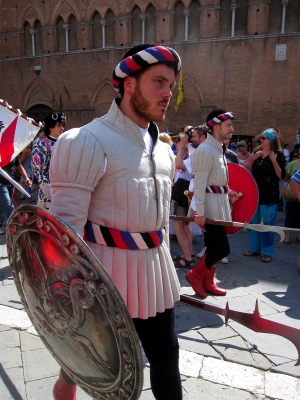Liberamente nel Campo di Siena / Ogni vergogna deposta, s’affisse.
(Freely upon the Campo of Siena / All shame being laid aside, he placed himself.)
-Dante, Purgatory, XI 134-135
Having been born in Louisville, home of the celebrated Kentucky Derby, I was pretty keen to hear about another famed horse race in Italy, the Palio di Siena. This race is generally held twice annually, on July 2 and August 16, and takes place in the town’s main square, the Piazza del Campo. A dirt track is laid out on the ground, bleachers are thrown up and the town takes a day off to carouse and carry on a centuries-old tradition.
My WWOOF host family was also curious and intrepid enough to venture into Siena, so we drove out and managed to land a parking spot not too far from the center of town. The city was in a festive mood, buzzing with energy, packed with gawking visitors and locals happy to have the day off. Many people were waving flags or wearing them around their necks to show their support for one of the 17 Siena contrade, or city wards. To delineate the borders between the contrade, colorful flags and lamps lined the streets and buildings. Residents take a lot of pride and identify with their contrada, which functions as a center for baptisms, marriages, deaths, festivals and other celebrations. It is advised that you do not marry out of your contrada!
Inside a tabbachi shop selling flags, I asked the clerk which contrada he thought would win. He pointed to the goose (oca), dolphin (onda) and turtle (tartuca). “The tortoise, I really think this one has the best chance,” he said. Turtles winning the race? I scratched my head but we followed his advice and purchased a tartuca flag, vividly colored in blue and gold, with a turtle emblazoned in the center.
Clockwise: Flags from the 17 contrade of Siena; a statue gazes out over the Palio racetrack; flags are tossed in synchrony into the air, clergy watch from the windows; she-wolf suckling infants Romulus and Remus (Siena was named after Senius, son of Remus)
Though public races were held in Siena as far back as the 14th century, the first modern-day Palio was held in 1656 after the Grand Duke of Tuscany outlawed bullfighting. The race is run bareback with ten horses, each representing a contrada. That means that seven horses are not included in the race. If a contrada is not part of the July 2 Palio, it is automatically entered in the August 16 race, and the other three slots are drawn by lottery. All horses are mixed, not purebreeds, in hopes that they will be stronger and less prone to injury. The course itself is not designed well, with dangerous sharp turns that often result in jockeys being thrown off their mounts. Luckily, it is the horse that crosses the finish line first that wins the race, so even a riderless horse can win the Palio.
On the morning of the race, each horse is blessed inside the church of its contrada. Then, people begin gathering near the campo, where you can pay a princely sum (~€200) for a seat on the outside perimeter, or you can stand inside the track for free. The only downside is that the track closes at 4:10 pm, so if you want to stay in the inner circle, you can’t leave and won’t have access to bathrooms or food until the race is over at about 7:45 pm. Since we had two small children with us, we opted to hang out at a bar instead and watch the race with an aperitivo in hand.
Cattedrale di Santa Maria Assunta, where people gather on the steps to watch the Palio processions; some very excited Aussies run through the Palio crowd
Before the race though, there is plenty taking place in the streets. At about 2:30 pm, we noticed large crowds gathering on the steps of the Siena cathedral. Shortly thereafter, we found out why. Large crowds of drummers, flag twirlers and other dignitaries from each contrada began parading into the square. With pomp and circumstance, they marched into the plaza, displaying their best medieval finery and wigs, then waved and threw flags in solemn demonstration. Supporters wearing contrada colors followed behind the procession, clapping and singing. I smiled as the Oca contrada joyously sang in the streets: “Sempre in alto le bandiere, sempre in alto il nostro amor!”
Jockeying for positions, in my opinion, is the most fascinating part of the Palio. In what can only be described as a very Italian process, the jockeys line up on the starting line in an order determined by lottery right before the race. Nine of the jockeys maneuver and fight their way into more advantageous positions, while the tenth horse, the rincorsa, waits just outside. For the next half hour, you can see jockeys split off, huddle together in conversation, negotiate, wheedle, browbeat and force their way into posts closer to the inside of the track. Deals are made and favors are granted. Sometimes jockeys try to squeeze their way in through speed and surprise. When the rincorsa moves himself to the starting line, the race begins.
The race itself is a fast-paced three laps around the track, and finishes in a blaze of excitement in 90 seconds. I held my breath as we watched the horses veer dangerously close to each other. And the final winner? Tartuca!! Just as predicted. Fast and steady wins the race after all.











So, “having been born in Louisville” and then enjoying Ithaca for a number of years, as well, I thought you’d enjoy this link of the Foodiest Towns in America!!
http://shine.yahoo.com/event/lifeslittlepleasures/bon-appetit-names-americas-foodiest-towns-2010-2389810/#photoViewer=1
That’s hilarious, clearly it was my living there that helped augment the towns’ foodie-ness!